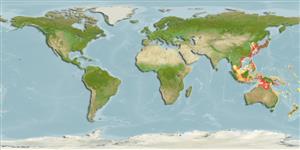>
Perciformes/Scorpaenoidei (Scorpionfishes) >
Aploactinidae (Velvetfishes)
Etymology: Erisphex: Greek eri = very, aumentative + Greek, sphex, -ekos = wasp (Ref. 45335).
Eponymy: Captain Constantin Edler von Pott of the ship ‘Pola’ was honoured for zoological collections made by that vessel in the Red Sea. [...] (Ref. 128868), visit book page.
More on author: Steindachner.
Environment: milieu / climate zone / intervalo de profundidade / distribution range
Ecologia
marinhas demersal; intervalo de profundidade 10 - 64 m (Ref. 86942). Temperate
Western Pacific: Japan (from Matsushima Bay and Niigata Prefecture southward) and southern coast of the Korean Peninsula. Recently reported from the Chesterfield Islands (Ref. 11897).
Tamanho / Peso / Idade
Maturidade: Lm ? range ? - ? cm
Max length : 12.0 cm TL macho/indeterminado; (Ref. 559); peso máx. Publicado: 23.40 g (Ref. 112063)
Espinhos dorsais (total) : 10 - 13; Raios dorsais moles (total) : 10 - 14; Espinhos anais: 1; Raios anais moles: 11 - 13. Body ovoid and compressed, covered with velvety prickles. Preoperculum with 4 spines. Dorsal fin notched behind the 3rd spine. Body dark-brown with indefinite darker blotches.
Body shape (shape guide): elongated; Cross section: compressed.
Occurs in shallow waters on sand or mud bottoms. Processed into animal feeds and fertilizers (Ref. 637). Neither anterolateral glandular groove nor venom gland is present (Ref. 57406).
Life cycle and mating behavior
Maturidade | Reprodução | Desova | Ovos | Fecundidade | Larvas
Masuda, H., K. Amaoka, C. Araga, T. Uyeno and T. Yoshino, 1984. The fishes of the Japanese Archipelago. Vol. 1. Tokai University Press, Tokyo, Japan. 437 p. (text). (Ref. 559)
Categoria na Lista Vermelha da IUCN (Ref. 130435: Version 2025-1)
Ameaça para o homem
Harmless
Utilização humana
Pescarias: espécies comerciais
Ferramentas
Relatórios especiais
Descarregue XML
Fontes da internet
Estimates based on models
Preferred temperature (Ref.
123201): 20.5 - 29, mean 28 °C (based on 554 cells).
Phylogenetic diversity index (Ref.
82804): PD
50 = 0.5625 [Uniqueness, from 0.5 = low to 2.0 = high].
Bayesian length-weight: a=0.00537 (0.00215 - 0.01342), b=3.14 (2.92 - 3.36), in cm total length, based on LWR estimates for this (Sub)family-body shape (Ref.
93245).
Nível Trófico (Ref.
69278): 4.1 ±0.47 se; based on food items.
Fishing Vulnerability (Ref.
59153): Low vulnerability (10 of 100).
🛈
